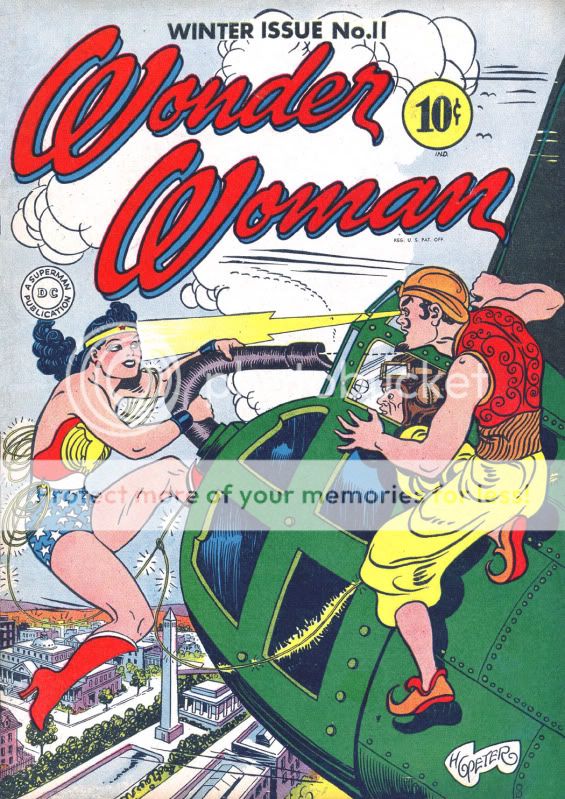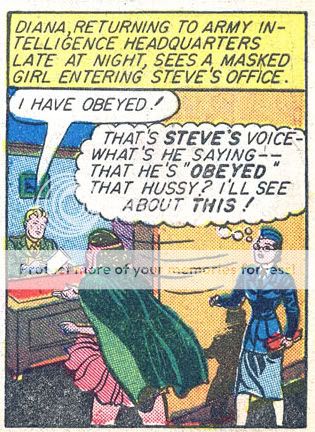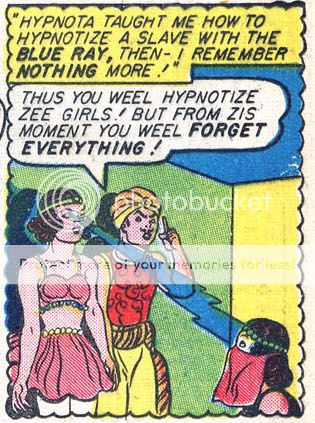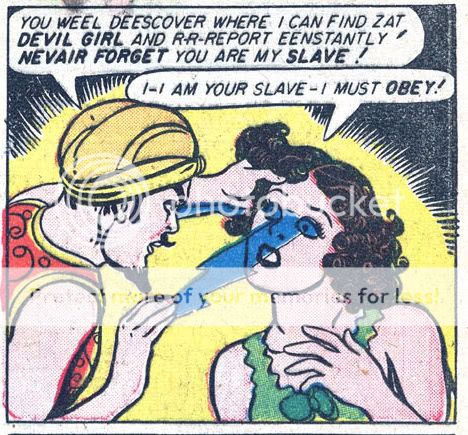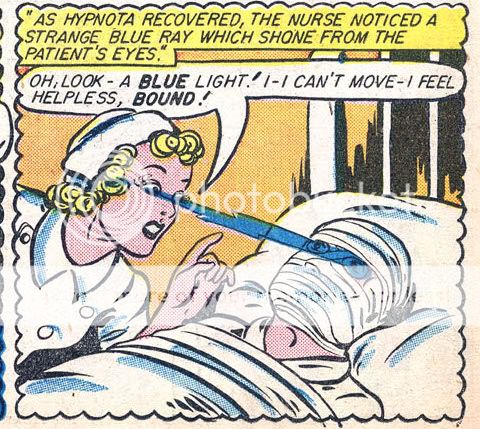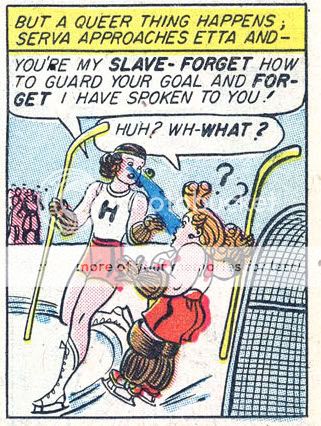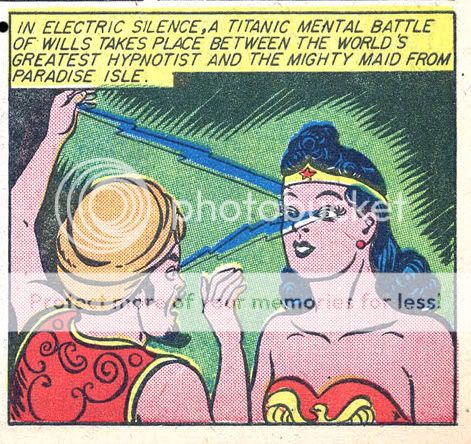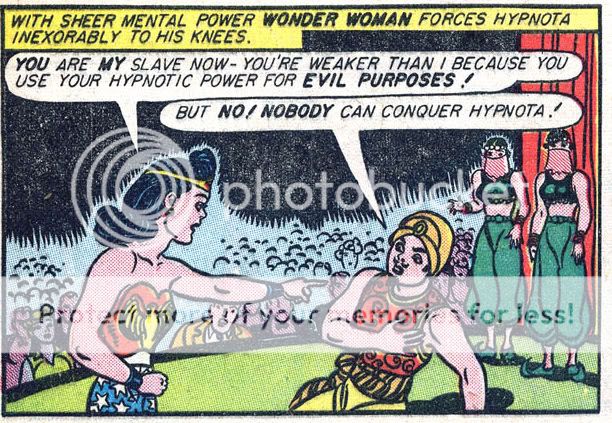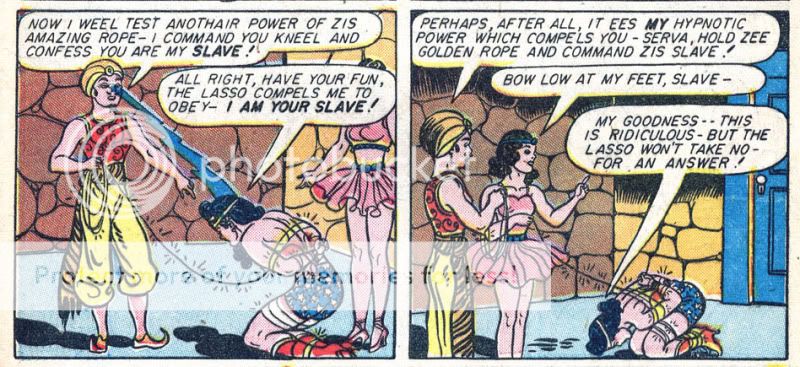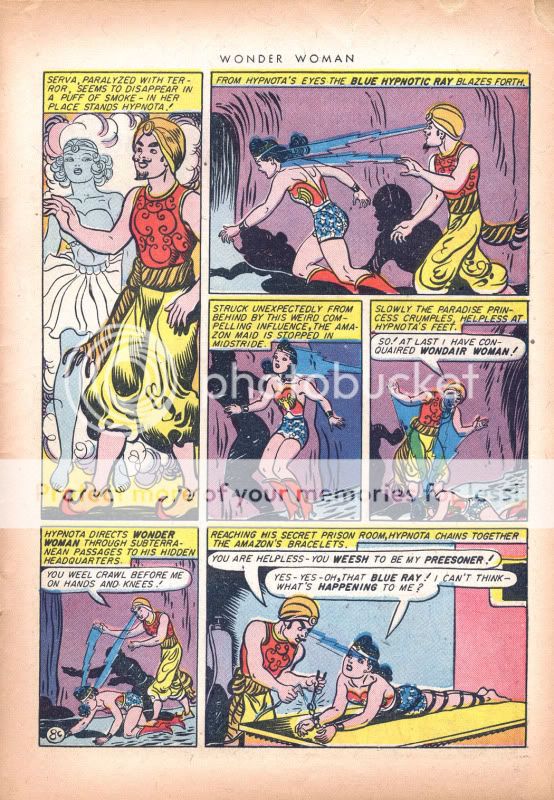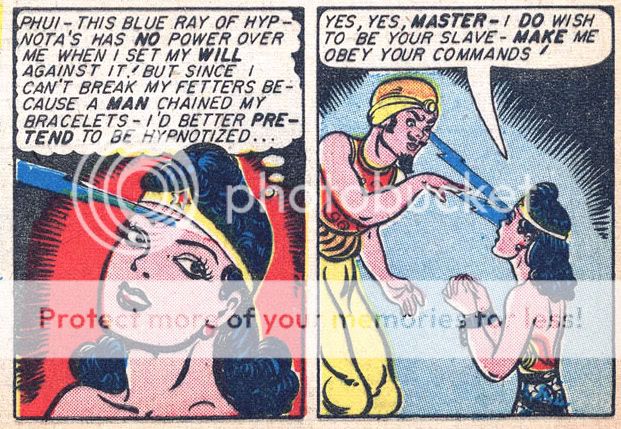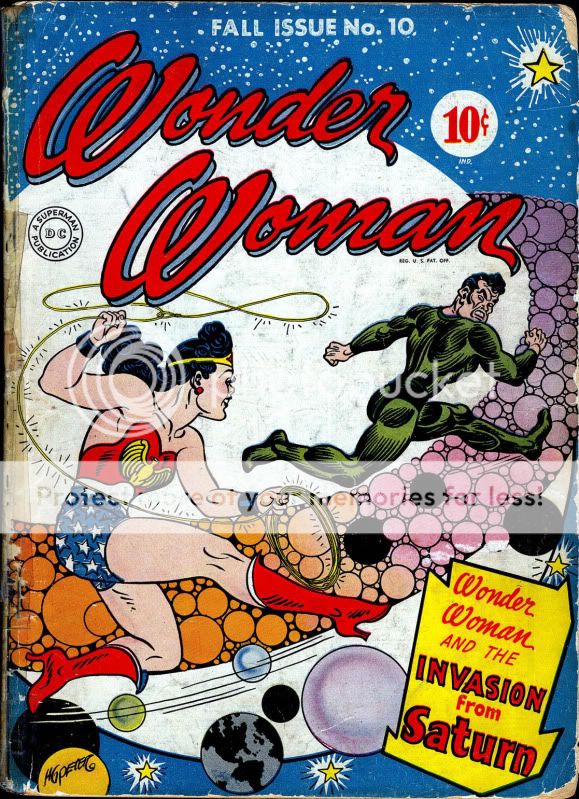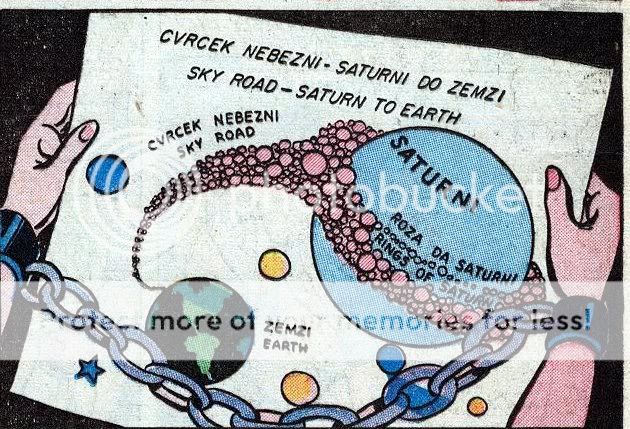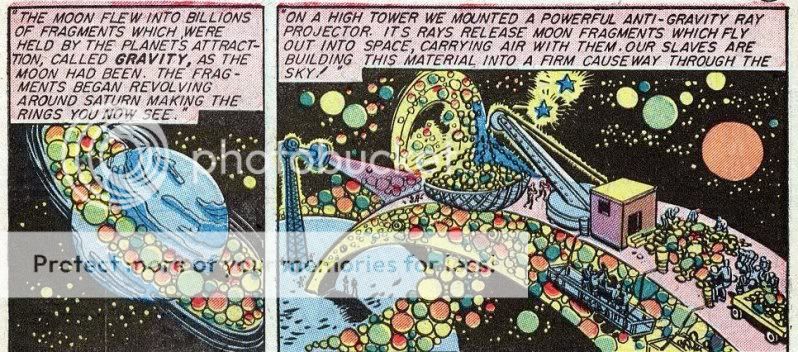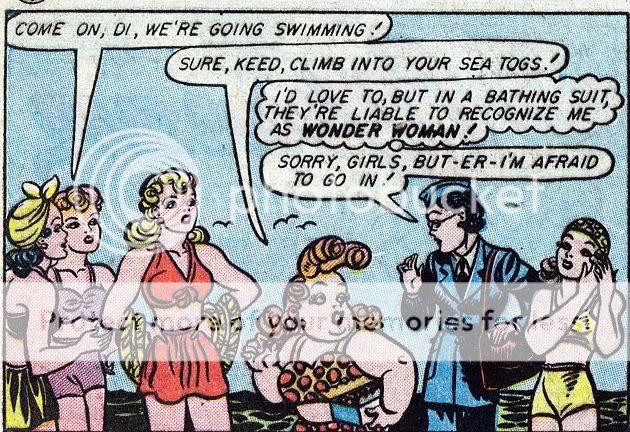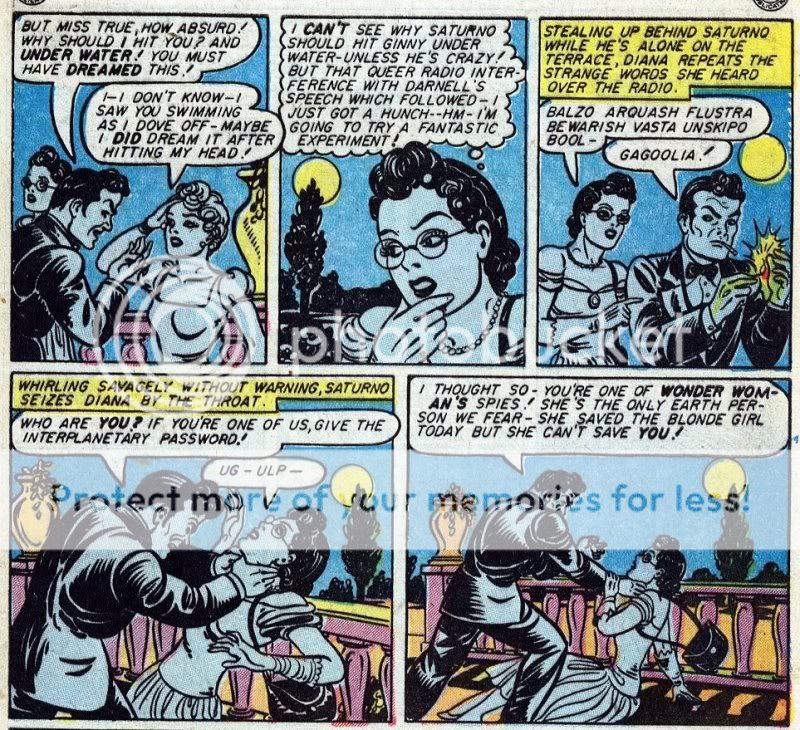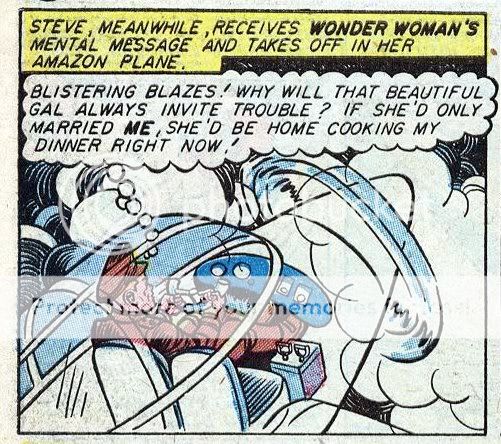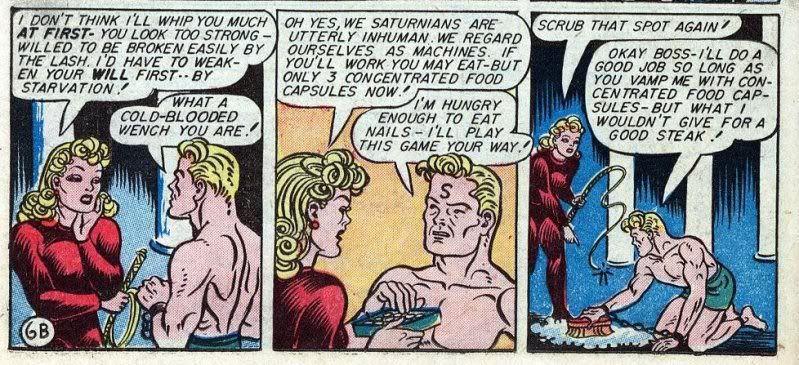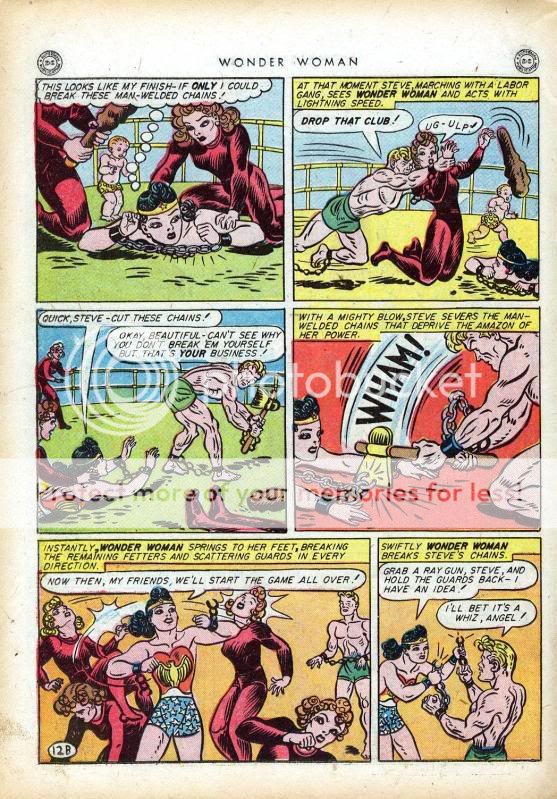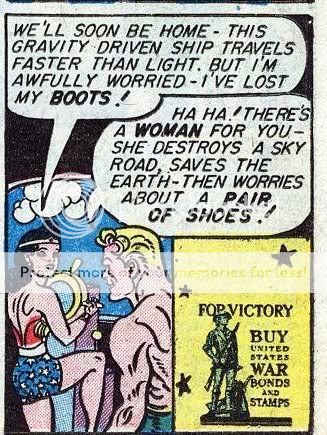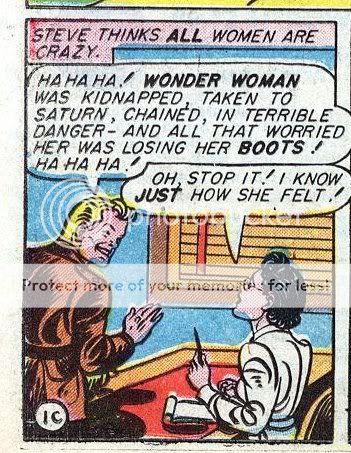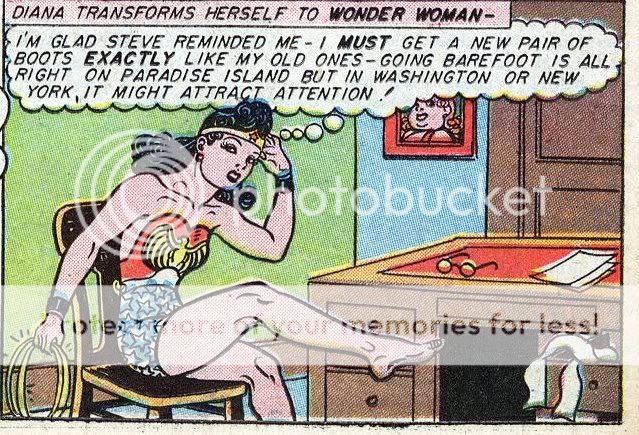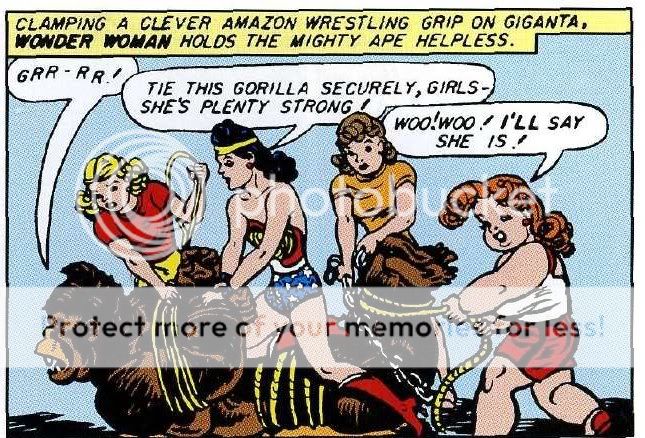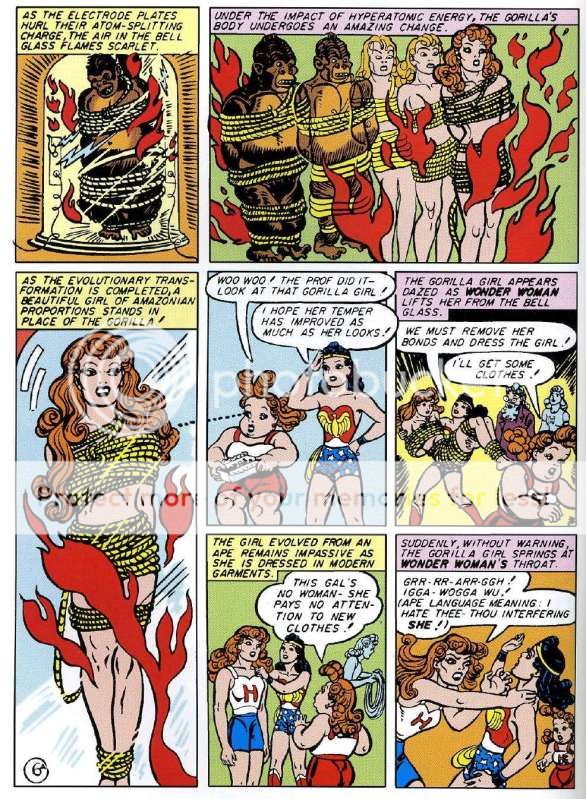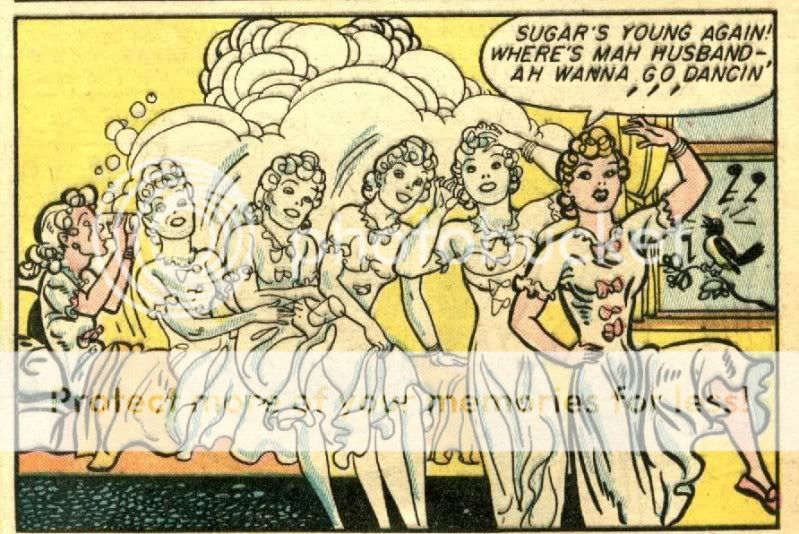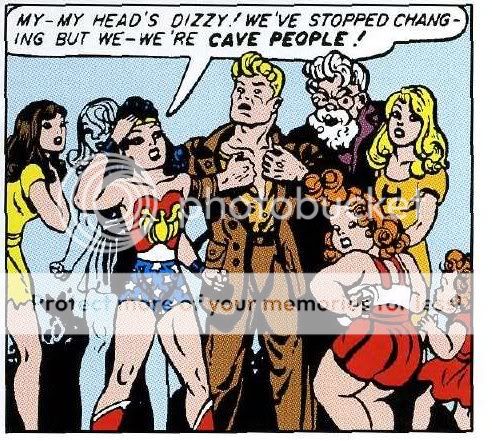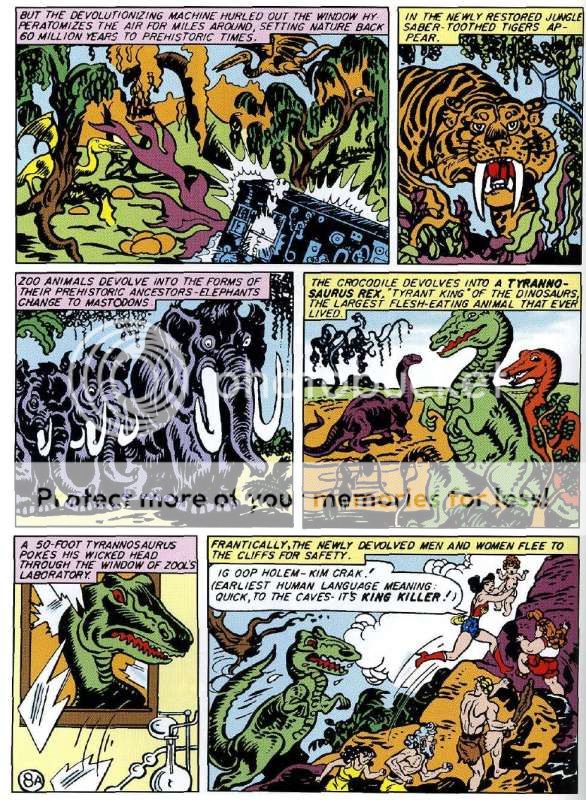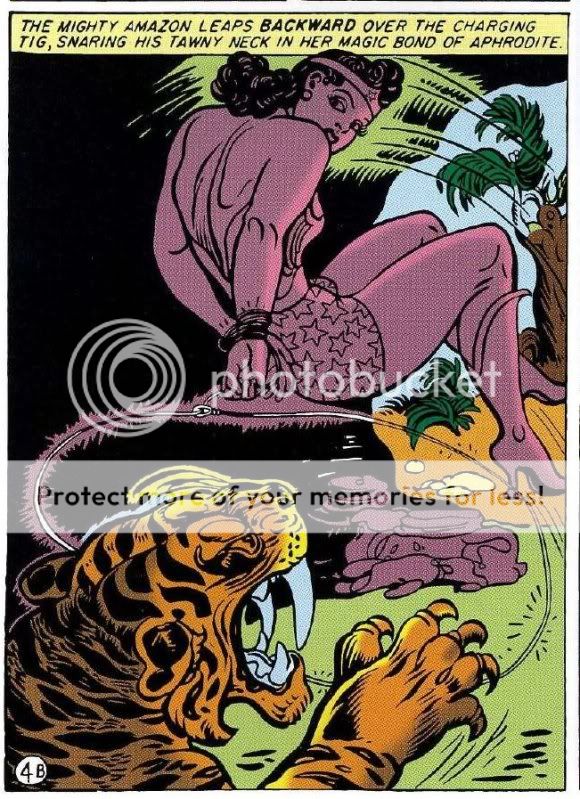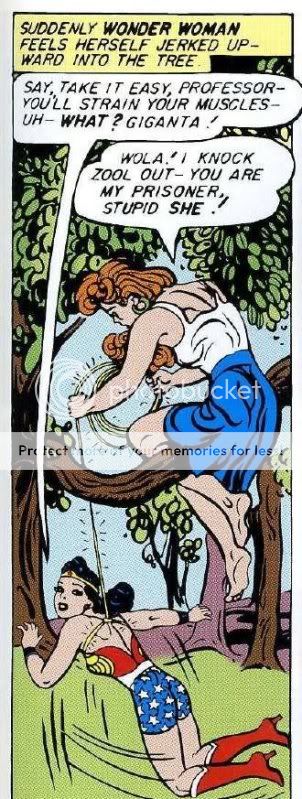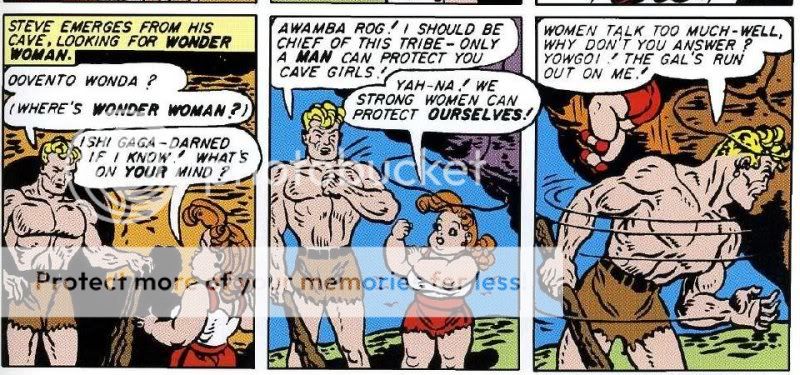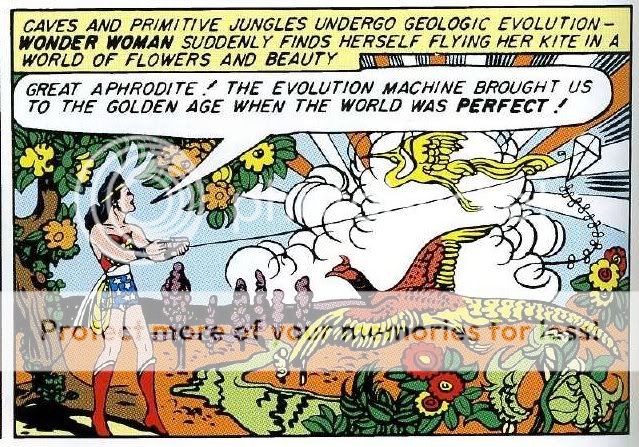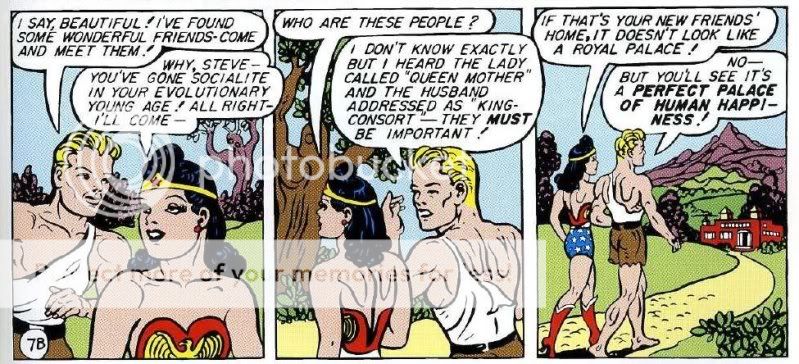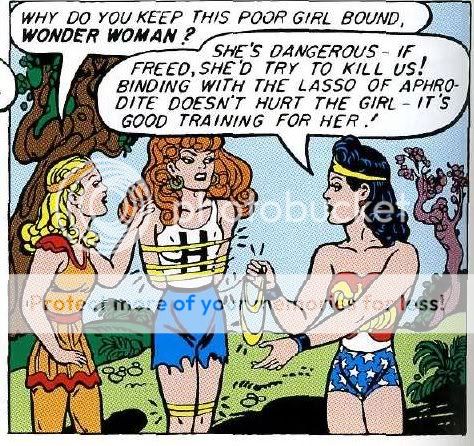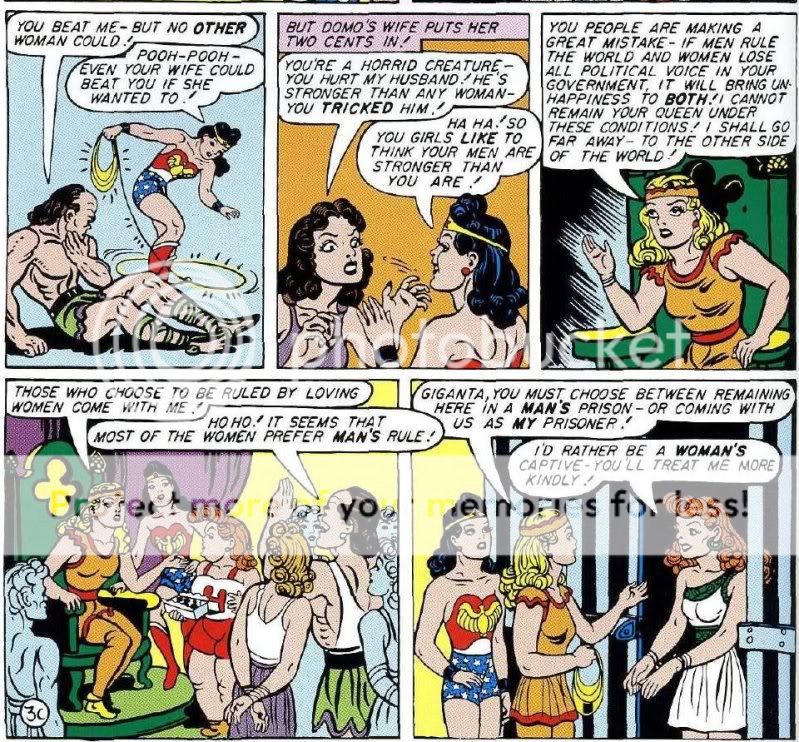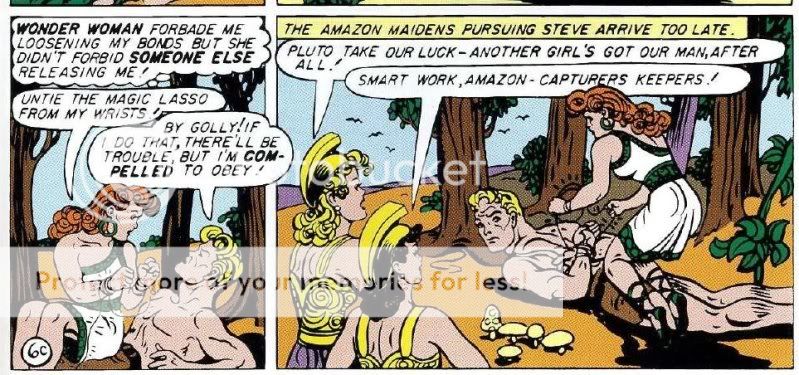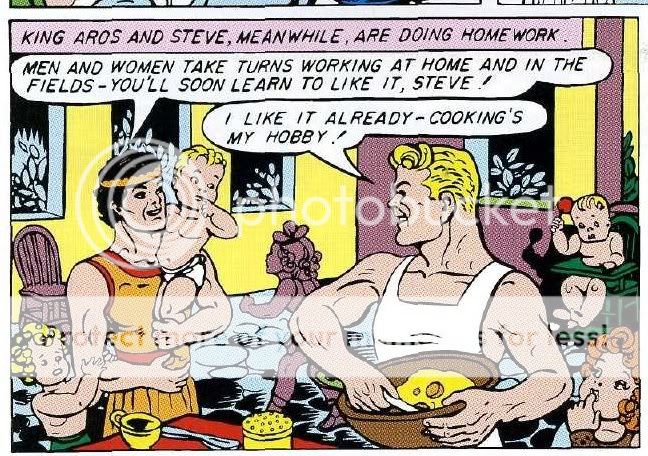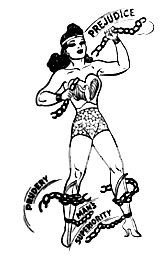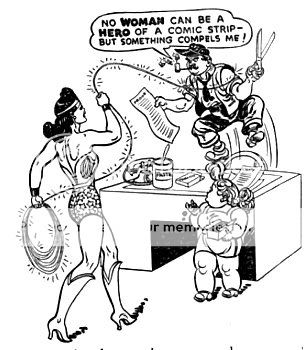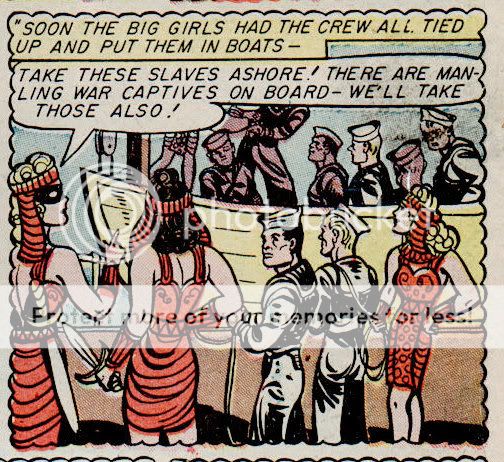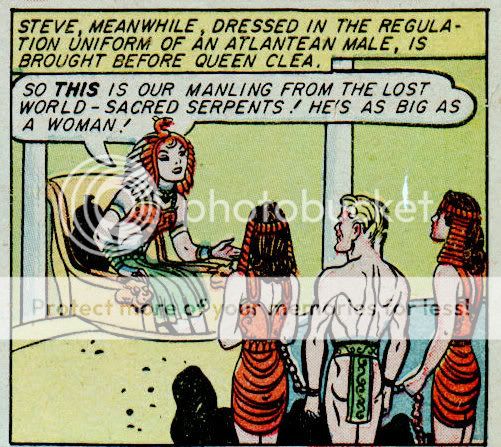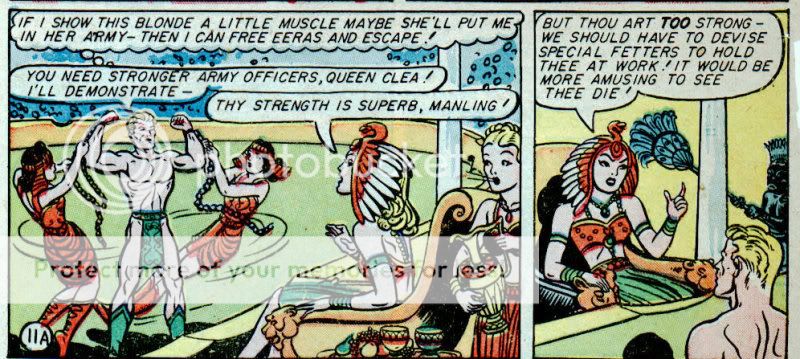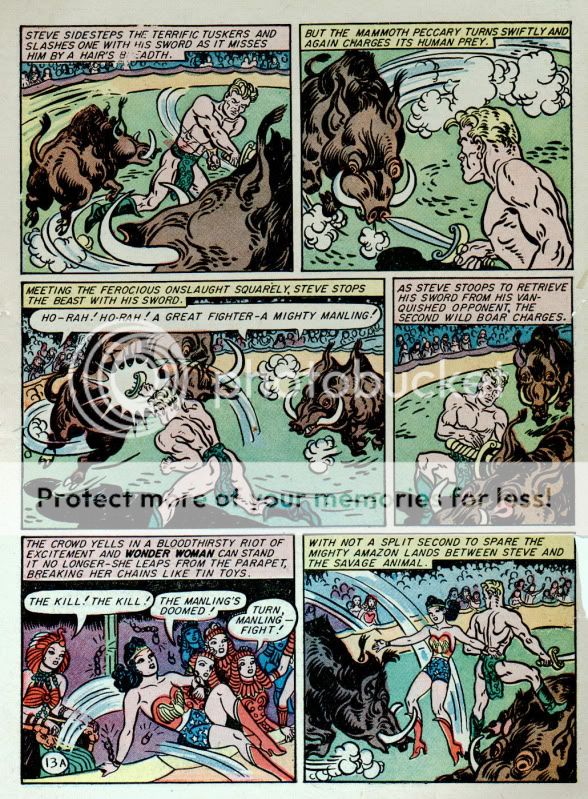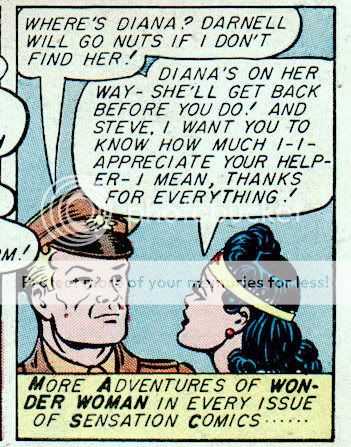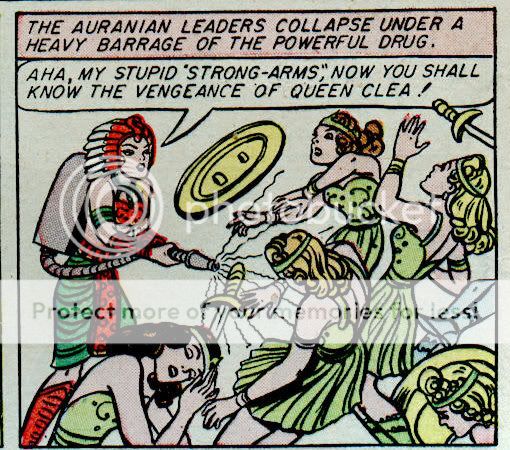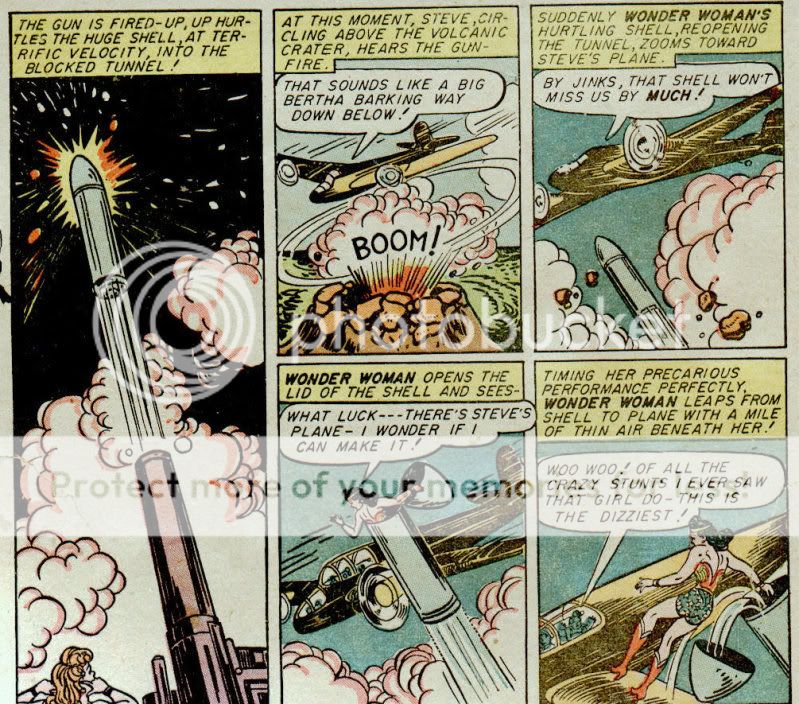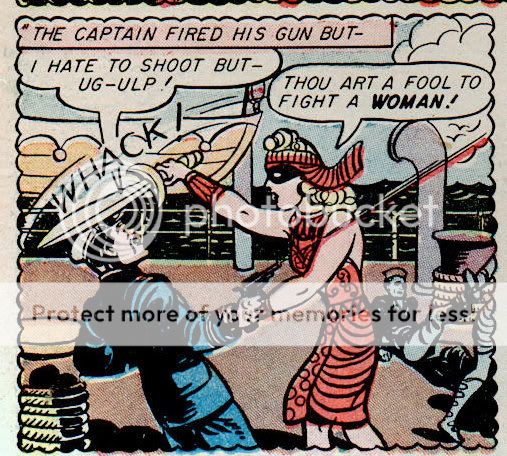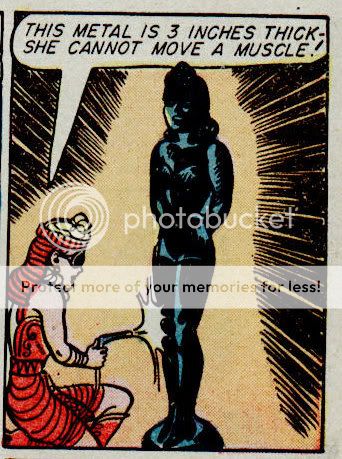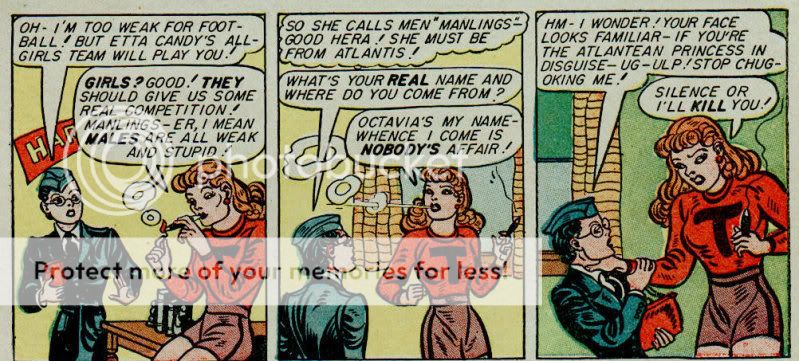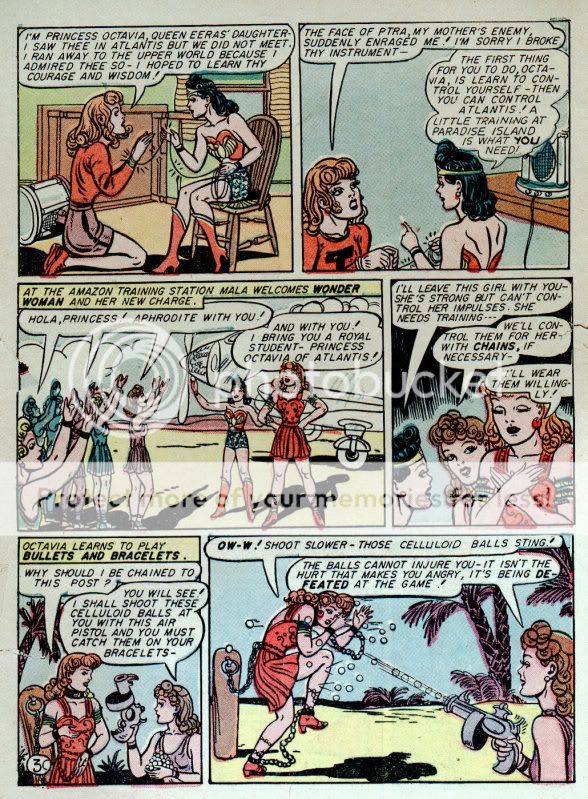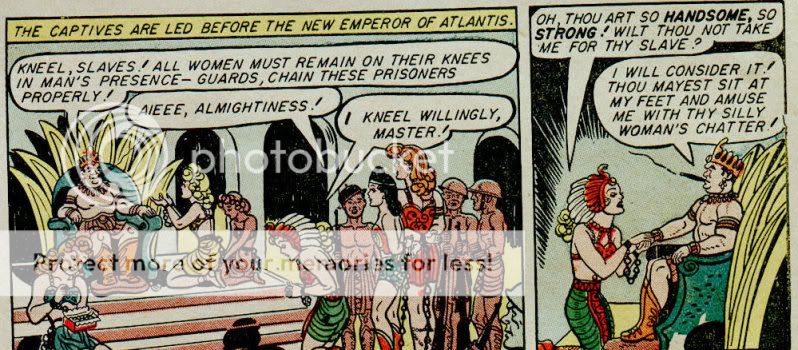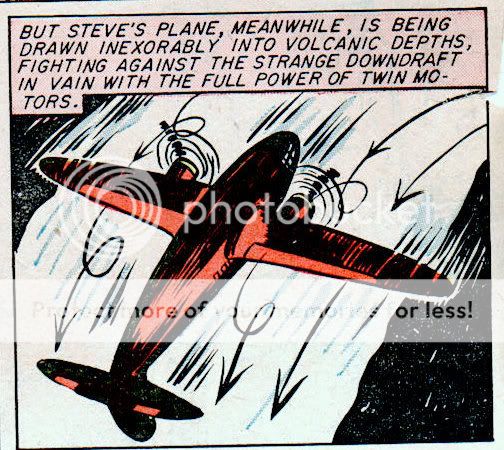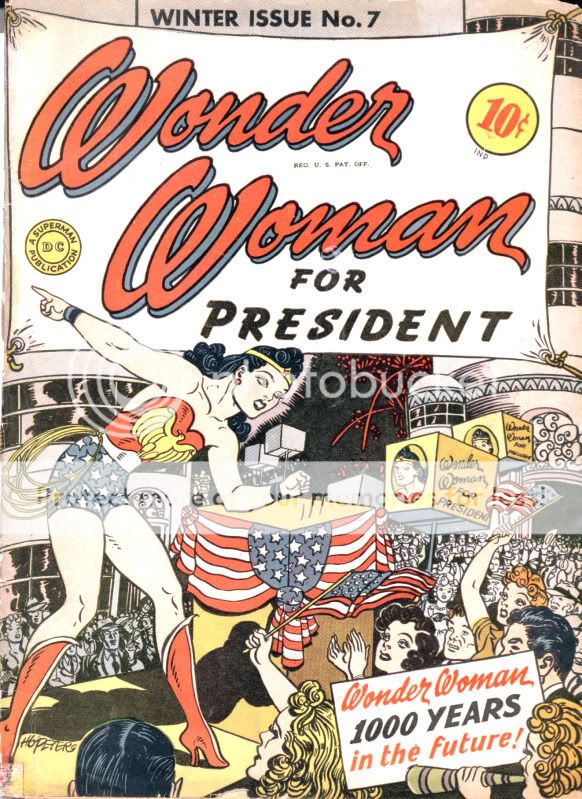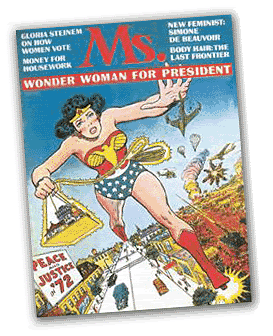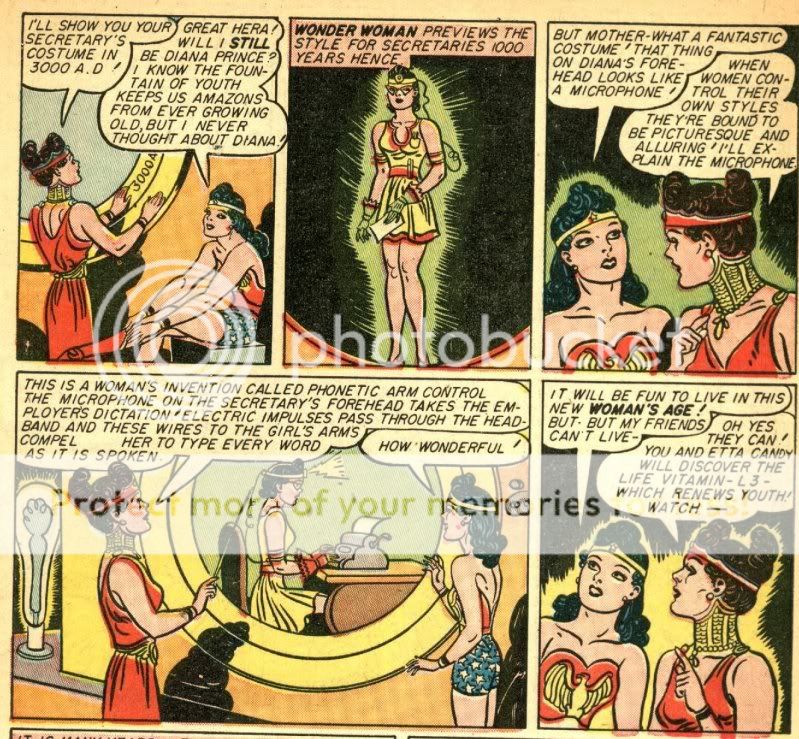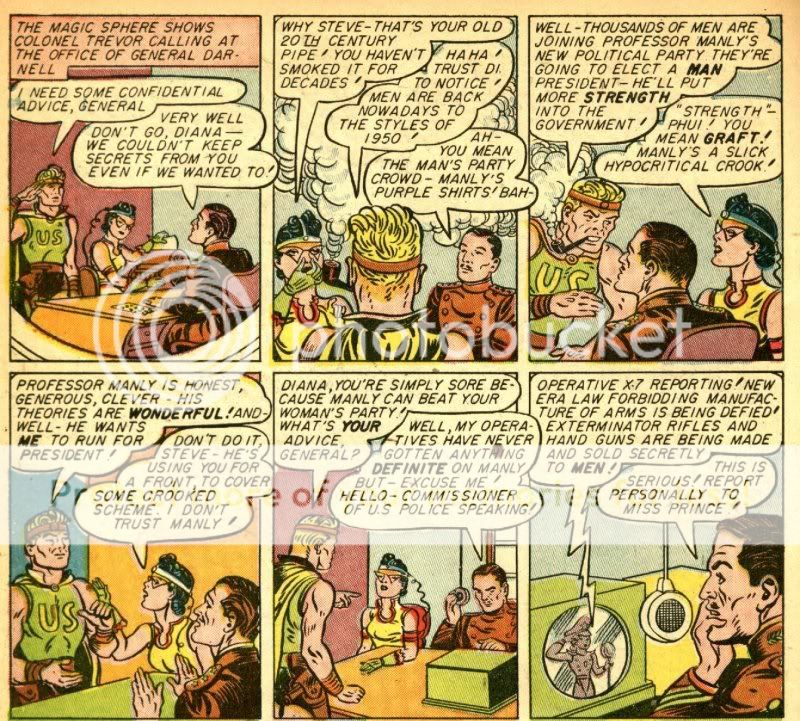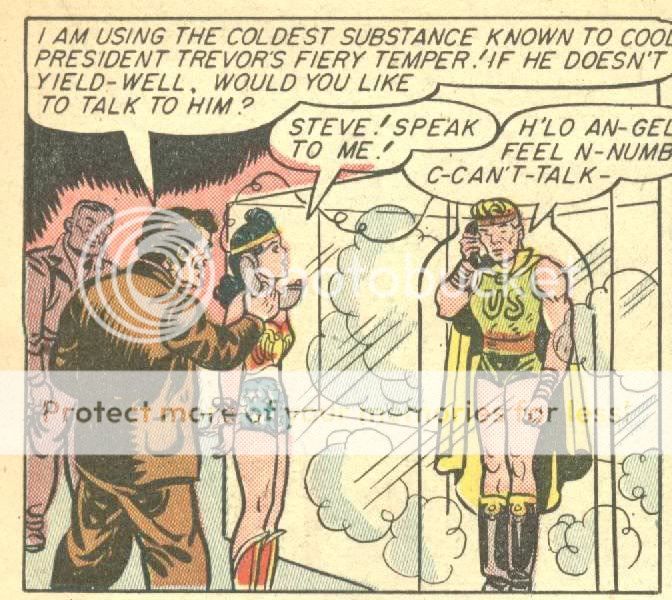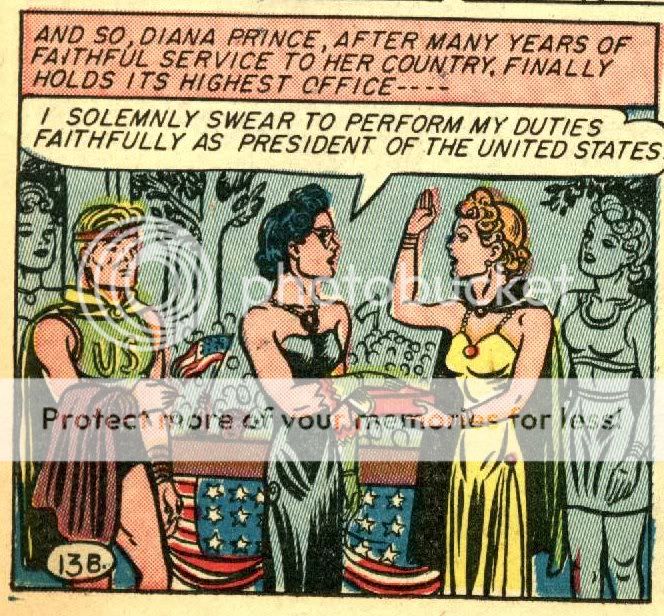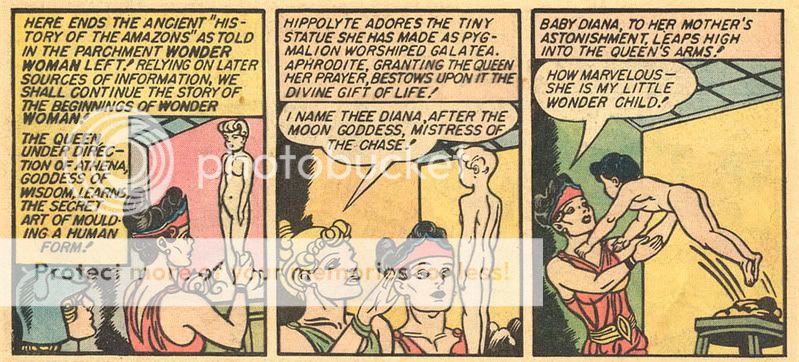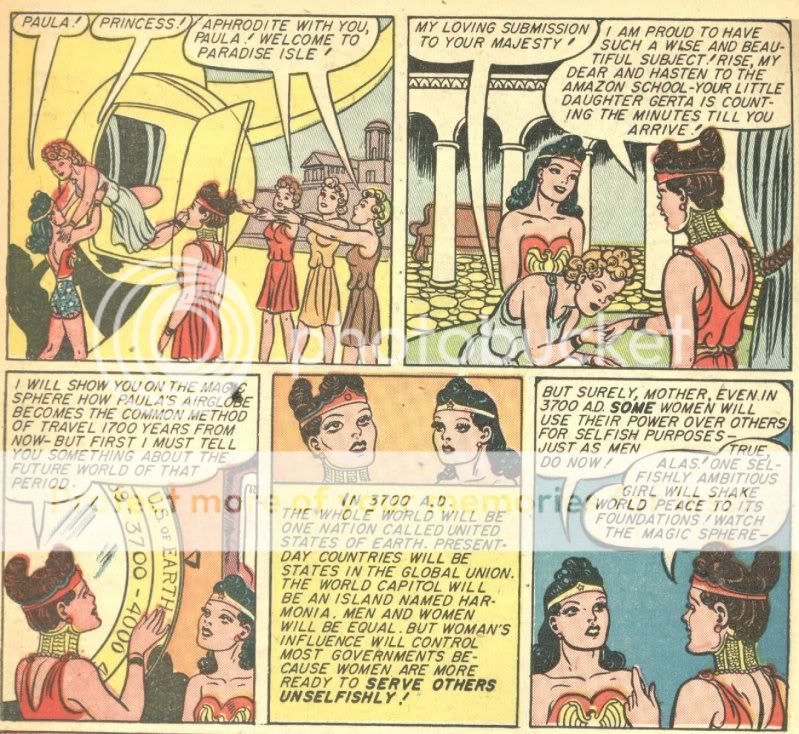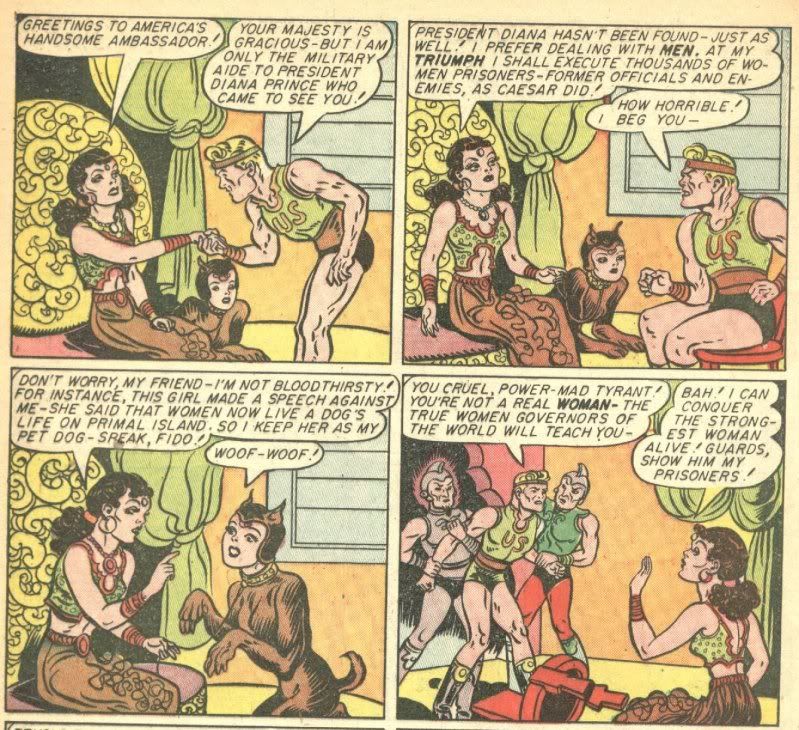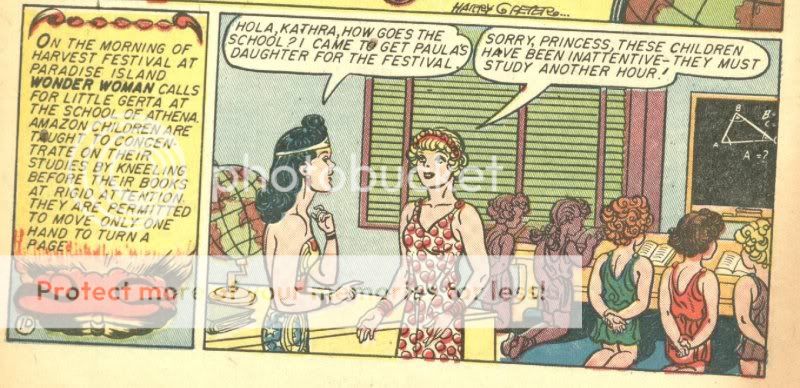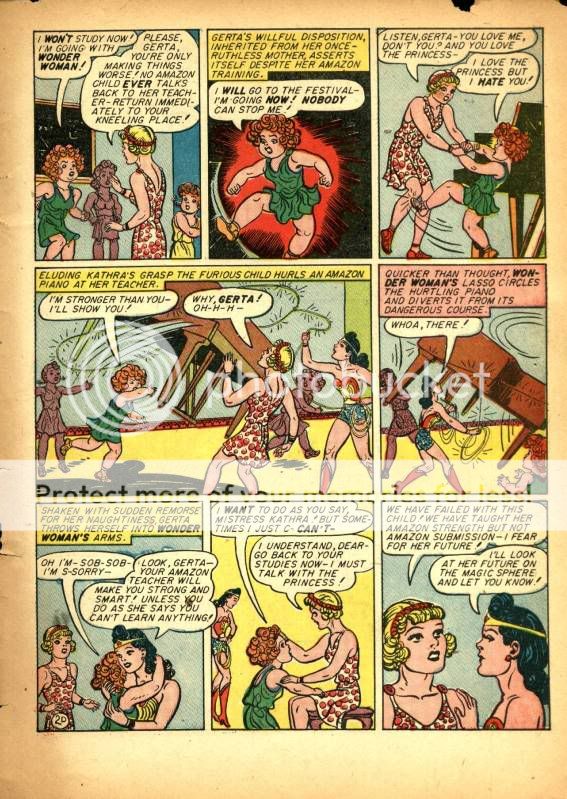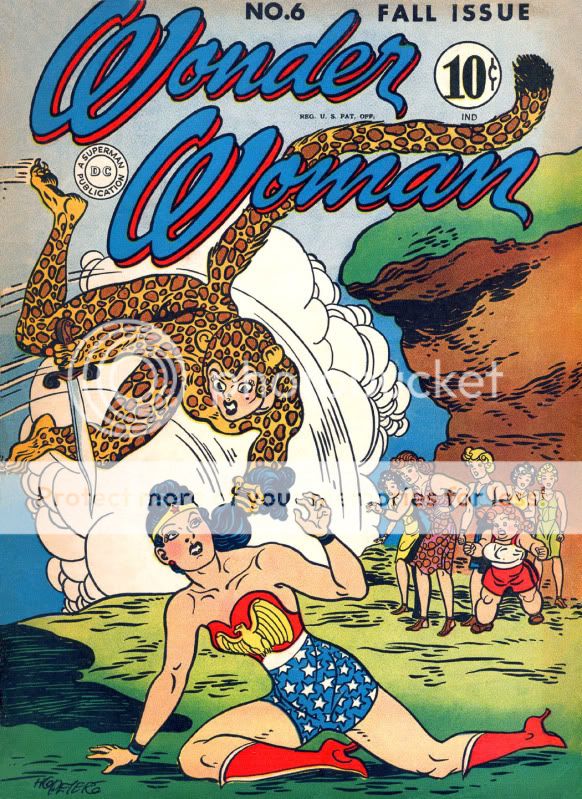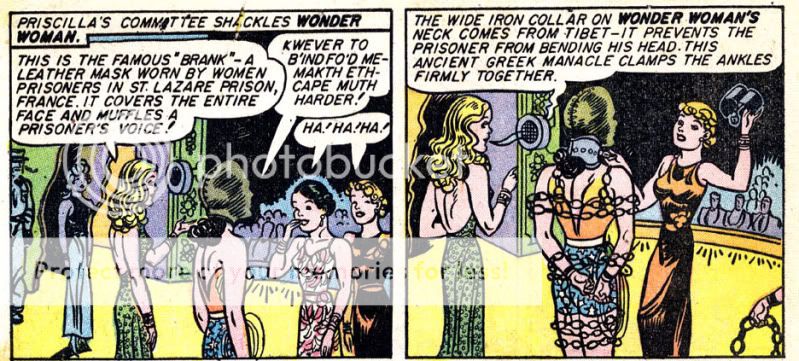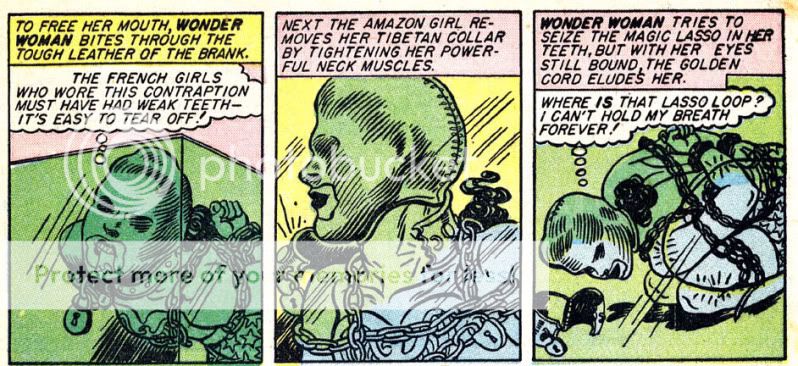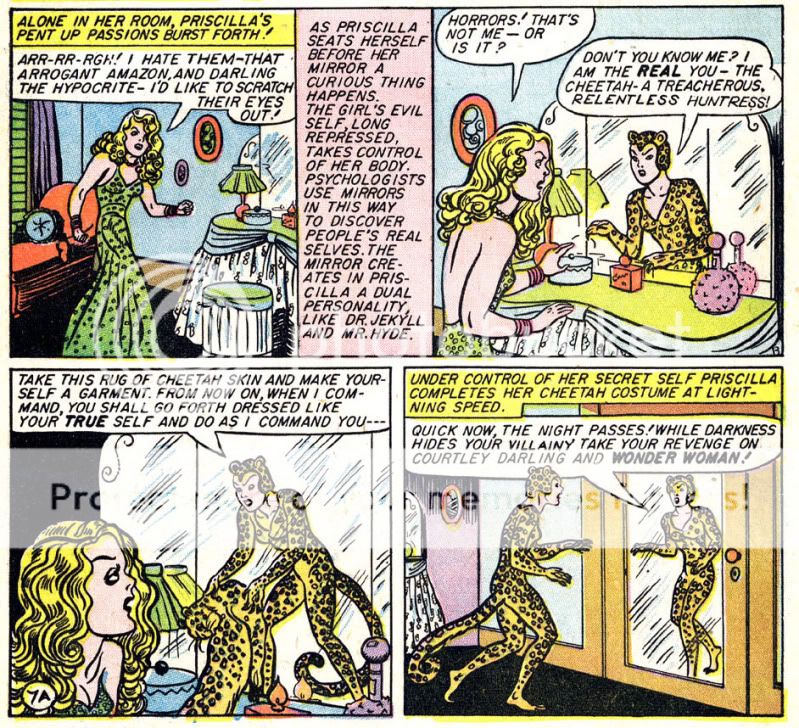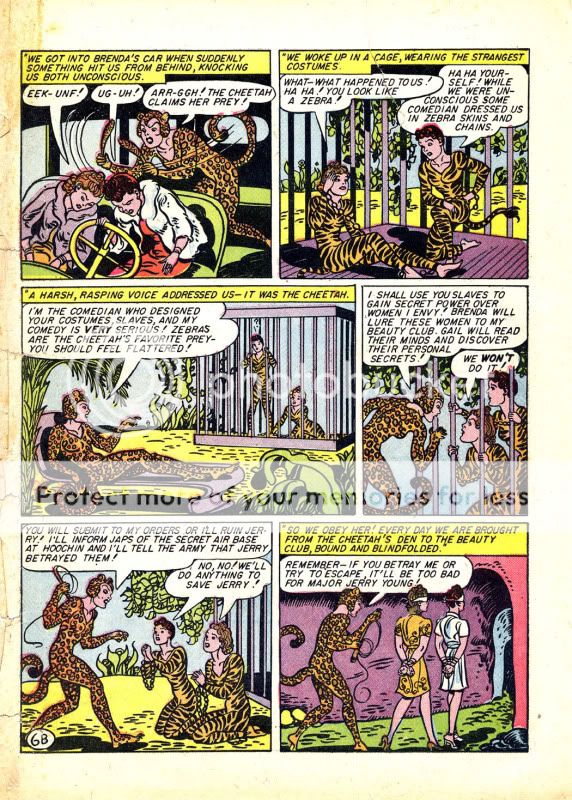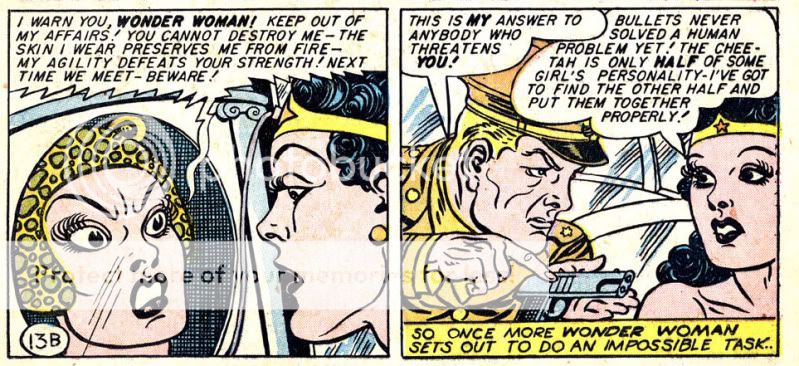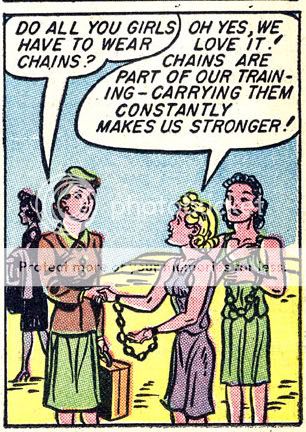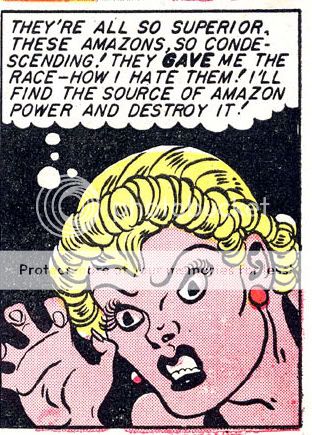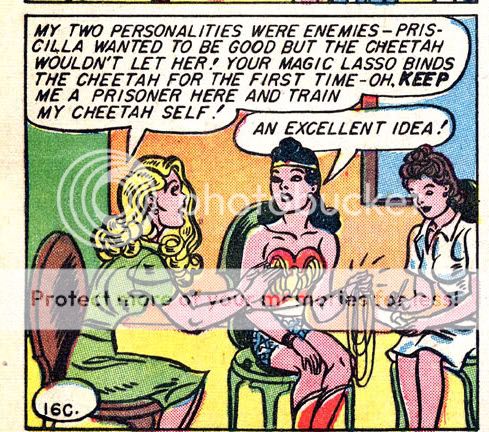I’ve been poking away at the Les Daniels “Wonder Woman: The Complete History.” It’s quite interesting, as much for the tidbits of information (Harry Peter did cartoons for Judge!) as for the topics it elides (there’s no way around the fact that Marston had sexual relations and lived with two women (Elizabeth Marston and Olive Richard). But the two women…what was their relationship exactly? Did that have any influence on the many, arguably sensual, female-female relationships in Wonder Woman. Daniels doesn’t even ask the question.
Anyway, at one point (page 34) Daniels talks a bit about WW’s villains:
It seems that Wonder Woman’s foes should have been male (and certainly many were), yet a surprising number of her most interesting and energetic opponents were female. Some of Wonder Woman’s comments indicate that men were just too feeble to be worthy antagonists. Marston was apparently intrigued by the dramatic possibilities of depicting Princess Diana battling various vivacious vixens (they were invariably gorgeous), or perhaps he had calculated that such encounters would be most appealing to male readers.
I’m sure Marston did enjoy the woman-on-woman action just fine. But at the same time, I’m not sure there’s any sense in which Wonder Woman’s opponents “should have been male.” It’s true, as Daniels discusses, that Marston wanted women to rule over men. But that’s not quite the same thing as saying that all women are good and all men are evil. On the contrary, Marston has plenty of good men (Steve Trevor, most noticeably, who is certainly noble, if often kind of dumb) and plenty of evil women.
Moreover, the use of women villains can’t just be chalked up to prurience. In several cases, as Daniels notes, male villains are revealed to actually be cross-dressing women at the last moment. If you’re going for the sex element, surely it would be more effective to have your villainous hotty wear a bikini or a diaphanous gown (as, of course, Marston frequently does) rather than deck them out in drag-king attire.
For example, as these things go, this just isn’t a very prurient cover:
The fellow decked out in the pseudo-orientalist get-up (very nicely rendered by Peter, I might add — love those art-nouveau curlicue patterns) is, we learn at the end of the book, actually a girl. Because Marston’s decided to dress the she as a he, we lose the opportunity for two sexy girls on the cover instead of one. Which is not the way to go for marketing purposes.
So if women-as-villain isn’t strictly for cheesecake purposes, what’s the deal? Daniels doesn’t really have an explanatory framework, because he’s stuck on Marston’s utopian claims about the goodness of women and the loving matriarchy. But if you actually read the Wonder Woman comics, it’s clear enough that, while Marston likes kind mistresses well enough, he also has a thing for cruel ones:
“Hussy” has definite sexual connotations; Diana sounds jealous that someone other than WW is forcing Steve to obey.
And similarly, this girl-on-girl hypnotism, with the kneeling veiled slave, surely has sexual connotations.
In short, Marston is fascinated by female power — as a force for good, sure, but also just in itself. The sexual payoff isn’t just in the opportunities for cheesecake (though certainly those are fun), but also in the enforced submission.
Which is to say, the fetish here is not attractive female bodies in disarray, but the hypnotism itself.
The first three are clear enough; hot girl in short skirt being controlled, hot girl in negligee being controlled, hot nurse being controlled (everyone likes nurses.) But — as someone with a bit of a button for eroticized mind-control I think I can say with some certainty that Marston got a thrill from that last one as well. The control and submission aren’t an excuse for the cheesecake; they’re the point in and of themselves. (Incidentally, WW comes onto the ice and saves the game (which was against a men’s team) for the Holiday college women.)
In other words, this is one place where Marston’s fetish and his feminism arguably part company; the use of control for evil purposes (or even for silly ones, as with Etta in the image above) is exciting. But this kind of control, thrilling as it may be, can’t really be described in terms of loving submission. The tension is most clear in those instances where it’s Wonder Woman who is placed in hypnotic thrall. As the Amazonian hope for a new tomorrow, WW generally makes others obey her with the use of her magic lasso (though that gets turned around a fair bit, too…but not to digress). But there’s obviously some payoff to be had by showing her will bent to the power of Hypnota. So how does Marston resolve things? Well, he vacillates:
On the one hand, we get to see WW all wide-eyed and receptive…..
But then she’s stronger than Hypnota….
But then she gets tied up in the golden lasso and has to submit; though only reluctantly (does that make it less or more appealing?)
She breaks out of that and gets free…but later, we do finally see her being taken over by Hypnota:
Though soon she’s back to being immune…and only pretending to be hypnotized….
Marston, in short, goes to some trouble to have it both ways. WW is both too heroic to be a thrall to the evil hypnotist…and yet, we also get to see her being a thrall to the evil hypnotist. Everybody’s happy!
It’s also worth asking…what’s the deal with all cross-dressing? Again, I think Marston is probably just fascinated with the possibilities of gender switching and dress-up in themselves.
It’s a little hard to follow what exactly the trick here is supposed to be…but basically Hypnota and her identical twin are switching places back and forth. I can’t really see any reason to devote this much space to it, other than Marston’s enthusiasm for the surreptitious swapping of clothes and bodies and genders.
In some versions of masochism, gender swapping is used to as a way to undermine or invalidate patriarchy. For instance, in Jack Hill’s women in prison movie “The Big Doll House,” we find out at the end that the sadistic torturer is actually a woman…which essentially makes it possible to rape her. (I talk about this at much greater length in this essay. Turning a man into a woman, in that case, seems like a way to sneer at, and get back at, authority; the mother invalidates the father.
There’s maybe a touch of this in Marston’s story as well. Hypnota binds WW hands…which should rob WW of her strength, if Hypnota was a man. But, of course, Hypnota isn’t a man…so WW retains her strength, and (after some confusion) to break free.
Overall, though…I don’t know. In Marston, femininity isn’t ridiculed…quite the contrary. In some ways, Hypnota’s power, influencing others, seems like actually like a corruption of feminine influence — the dark side of WW’s magic lasso. From that perspective, you might see Hypnota’s cross-dressing as a sign that she’s using female power for evil male ends.
Again, though, I’m not quite sure that’s right. If cross-dressing were a sign of evil, then cross-dressing should itself be evil or wrong — and I don’t know that Marston thinks it is. Hypnota seems quite natural; as a man, she’s slender and boyish looking, perhaps, but not noticeably unattractive.
The truth is that, Marston can tend to see masculinity as wrong or deformed; men like Hercules and Dr. Psycho are caricatured and even ludicrous in their maleness. In some sense, Hypnota — who isn’t caricatured at all — is a better man than either of those real men. Women, for Marston, can and should do anything…and that includes being men.
Or being super-villains. After all, had Marston decided to make all his villains men, he would have robbed women of some of the best roles in the comic. It’s not necessarily especially feminist to paint all women as pure and virtuous and good. Why should men get to be the only ones who are powerful and bad? Marston seems to think it’s more fun for everyone, male and female alike, if women get to be villainesses, and villains too.

